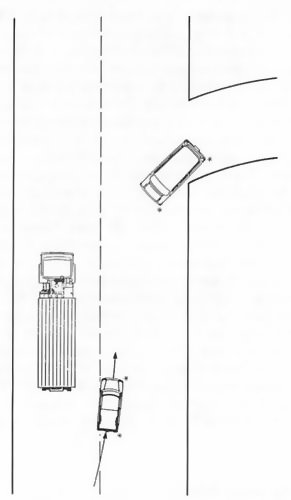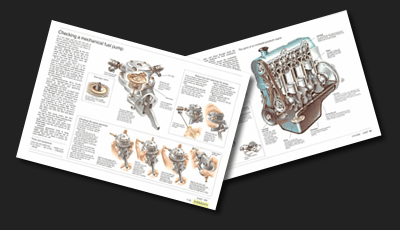Every aspect of overtaking is related to one of the basic rules of safe driving and therefore discussed in other articles on the site. There are some specific points about overtaking, however, which you should always bear in mind.
Why and when?
The first question you should ask yourself, whenever you consider overtaking, is whether the manoeuvre is strictly necessary. If you wish to pass a slow-moving vehicle which is genuinely impeding your progress, and can do so safely, then by all means overtake. Very often, however, overtaking is pointless if it serves only to move you up one place in a line of traffic. Do not let an instinctive desire to get ahead encourage you to overtake; your manoeuvre should be motivated only by the practical consideration of improving your progress during a journey.
The second question — when to overtake — is even more important. On an ordinary road, overtaking means that you must spend time on the wrong side of the road, which is an exceedingly dangerous place to be. Careful planning, rapid thinking and decisiveness are all essential. You must be certain that the road is clear far enough ahead to allow you to pull out, accelerate, overtake and pull back in again without alarming an oncoming driver in the distance or causing the driver you are passing to take action to help you out of a sticky situation. Overtaking can take a considerable time, even if you use all the acceleration available to you. If an approaching vehicle comes into sight over a brow or round a bend while you are still making your manoeuvre, you could be in trouble and you will scare the drivers around you.
This video course is the best way to learn everything about cars.
Three hours of instruction available right now, and many more hours in production.
- 4K HD with full subtitles
- Complete disassembly of a sports car
Be aware of the relative speeds involved. If you overtake at a speed of 60mph and the vehicle you are passing is doing 40mph, you haul it in at only 20mph. If an oncoming vehicle is travelling at 60mph, the rate at which the two of you close is 120mph (60mph + 60mph), a speed at which a long gap shortens very quickly. You do not have to be good at arithmetic to understand that a dangerous situation can develop rapidly if you make a mistake in your timing. You cannot make mistakes when you overtake.
Besides assessing whether there is time to overtake safely, the operation must be planned with great care, not with the air of optimism which a few irresponsible drivers employ. As well as allowing for oncoming vehicles, you must be prepared for the driver who might come out of a side turning, drive or lay-by. He may pause at the main road, look to his right to check that nothing is coming on his side of the road and then pull out; it might never occur to him that an overtaking car could be approaching from the left. Since this terrifying scenario happens with appalling frequency, you should never overtake when you can see a side road ahead, even if there is no vehicle visible when you are considering the manoeuvre. It is impossible to allow for a concealed drive or lane which has no signpost, but always be prepared for the possibility and be ready to sound the horn and/or flash the headlights to draw attention to yourself if a vehicle does appear from `nowhere'.
Overtaking procedure
Dangers of overtaking at a side road. You should never overtake when you can see a side road or lay-by ahead, even if no vehicle is visible.
After checking the why and when of overtaking, you should turn your attention to how you will carry out the manoeuvre. Once you have satisfied yourself that there is plenty of room for you to overtake safely, you should check your mirror before starting to move out. You must not be so close to the vehicle ahead that you need to move just to see whether the road is clear, and you must be certain when planning to overtake that there is a suitable gap ahead for you to pull in again safely. You should be especially aware of this point if the vehicle in front is a large lorry which conceals the traffic directly ahead of it; it is quite common for a driver to embark on a manoeuvre only to find that he has to pass two or three lorries in one go, not one.
If there is no-one behind you who is about to overtake and no-one already coming up on the outside (and possibly briefly out of your view in the mirrors), give a right-turn signal, change down to a lower gear for stronger acceleration if necessary, and press the throttle firmly but smoothly as you move out. The gear you choose should be able to get you through to the completion of the manoeuvre before the engine revs reach the point where you need to change up. This will enable you to keep both hands on the wheel throughout the exercise.
As your car draws level with the rear of the vehicle you are about to pass, keep a careful eye out for any signs that the other driver might change course, perhaps by overtaking the vehicle in front of him or turning right. It is more than a slim possibility that he will do either without checking in his mirror or signalling. If he starts to move, or even if you suspect that he might, give one or more sharp blasts of the horn to warn him of your presence. This practice is used frequently on the continent, and ought to be used more willingly by drivers in Britain.
Some people seem to resent being overtaken and behave quite insanely. They may even close the gap ahead of them to shut you out in the right-hand lane or accelerate while you are passing. Always keep your temper under control and resist any urge to retaliate, either by trying to race the driver or carving your way into the shrinking gap ahead of him; two angry drivers are twice as dangerous as one. Treat such stupid behaviour in the only sensible way, by pulling back into place behind the vehicle.
Thankfully, the other driver will almost always let you through, so it is then up to you not to cut back in front of him. As soon as the vehicle appears in your mirror, it is safe for you to return to the correct side of the road.
Summary
- Why? Always ask yourself whether an overtaking manoeuvre is really necessary.
- When? Ensure that you always overtake safely, when there is plenty of time available to complete the manoeuvre. Do not overtake if you would have to pass a side turning while doing so, even if no vehicles are waiting to pull out on to your road.
- How? Check your mirror and signal before moving out; engage a lower gear if necessary and accelerate firmly but smoothly; do not cut in sharply at the end of the manoeuvre; be prepared for foolish behaviour from the driver you are passing.




